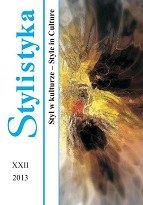СЕМАНТИЧКА ФУНКЦИА РИМЕ У ПOЕТСКИМ СТРУКТУРАМА
The semantic function of rhyme in poetic structures
Author(s): Milosav Z. Charkic Subject(s): Language and Literature Studies
Published by: Uniwersytet Opolski
Keywords: rhyme; semantics; synonymy; antonymy; Serbian poetry
Summary/Abstract: If viewed from a purely linguistic standpoint, rhyme belongs to the phoneticphonological and lexical levels of natural language. It draws on two basic linguistic planes: the plane of expression and the plane of content, which are inextricably linked and closely interwoven. The ways of formal linking of rhyming units result in the creation of different forms of rhyme, where the formal properties of rhyming range from complete to partial correspondence of the rhyming phonological material. This results in the creation of various forms of rhyme, such as the following: tautological (lexical) rhyme, homonymic (homographic) rhyme, echo-rhyme, prefixal rhyme and suffixal rhyme. Each of these kinds of rhyme, except the suffixal, expresses one semantic category, while the suffixal rhyme potentially includes five semantic categories: (1) lexical synonymy; (2) contextual synonymy; (3) lexical antonymy; (4) contextual antonymy and (5) multifarious meanings. The analysis of these semantic categories (all the nine of them) is limited by the scope of this paper, and includes one example from Serbian poetry for each of the identified semantic categories respectively. Our analysis has demonstrated that the semantic function of rhyme depends directly on the type of form (the kind of rhyme), i.e., on the way of structuring the phonological (sound) material in the rhyming of lexical units.
Journal: Stylistyka
- Issue Year: 2013
- Issue No: XXII
- Page Range: 75-90
- Page Count: 15
- Language: Serbian

